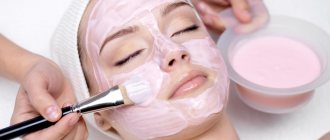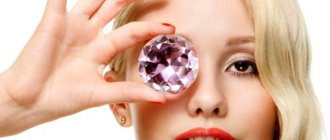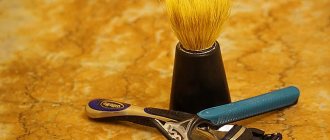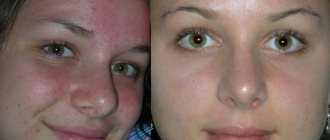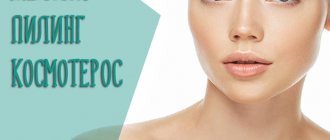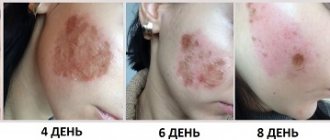Mechanical peeling is a popular procedure in cosmetology, which involves polishing the skin to make it clean and completely smooth. This is one of the options for exfoliation - the most common, but rather rough procedure. Mechanical peeling of the stratum corneum of the skin is performed manually or using a machine method. To increase the effectiveness of the procedure, natural abrasives are used, such as sea salt or sugar, ground coffee or seeds, powder made from sand, coral, or diamonds.
Types of mechanical peeling
Scrubbing is the simplest and, as a result, popular method of exfoliation. During the procedure, creams or gels containing silicone micro granules, crushed nuts and fruit seeds are used. In addition to professional exfoliating agents, natural ones are also used, consisting of honey or natural vegetable oils, sea salt, sugar, coffee grounds, crushed oatmeal. Such products are applied to pre-moistened skin, massaged for several minutes, and then washed off.
Peeling-gommage is a gentle exfoliation technique that combines some principles of mechanical as well as chemical exfoliation. The preparations used for this procedure contain enzymes or organic acids. On the surface of the skin, they soften its top layer and pores. After drying, the peeling gommage is rolled off, and the treated area is rinsed with slightly warm water.
Peeling-brushing is a mechanical-hardware exfoliation that involves the use of an electrical cosmetic device with various replaceable attachments - a brush, pumice stone, and a washcloth. The nozzle of the running device rotates, thus exfoliating the stratum corneum. The size and hardness of the brushes are selected individually, taking into account the type and specific characteristics of the skin, as well as the area of the procedure.
Dermaplaning is an innovative cosmetic procedure that was developed in Asia. The procedure is a little similar to shaving hair, but instead of a traditional razor, a special tool is used that is more like a scalpel. Dermaplaning for the face has several main goals, including removing the stratum corneum, getting rid of vellus hair, as well as small scars formed after acne.
Sandblasting dermabrasion is a variant of hardware exfoliation, during which exfoliation is carried out by the action of a stream of microscopic particles. Salt, soda, magnesia, and corundum powder can be used as abrasives. Microcrystals of these substances, released under a certain pressure, disrupt the integrity and remove stubborn dirt, as well as epithelial particles.
Fish peeling is a very exotic SPA procedure, including mechanical exfoliation techniques and elements of ichthyotherapy. During the procedure, the stratum corneum is not polished off, but is eaten by Garra rufa - small fish. Fish peeling is completely painless and was originally intended for the treatment of chronic diseases such as eczema and psoriasis. Nowadays, many spa centers and salons offer the procedure as a “fish” pedicure or manicure.
Mechanical peeling: absolute contraindications
1. Thin and sensitive skin, prone to rosacea. 2. Violation of skin integrity. 3. The presence of pustules, herpetic rashes or neoplasms. 4. Tendency to form keloids. 5. Psychosomatic disorders.
It is recommended to do this procedure no more than once every two weeks. To ensure effectiveness, exfoliation must be carried out in a course of six to ten procedures. The interval between courses should be from 4 to 12 months.
Preparing the skin for peeling and care after it
Before starting the procedure, you should completely remove makeup and wash with a gentle antiseptic foam. Upon completion of the procedure, apply a mask to the skin, and then cream or serum. For about seven days after the procedure, you should use a highly effective sunscreen before each time you leave the premises. And any cosmetic preparations containing retinol or alpha hydroxy acid should be replaced with products containing Aloe vera, witch hazel, chamomile, panthenol.
Almond peeling – professional superficial exfoliation of the skin with mandelic acid. This acid is made from bitter almonds and belongs to AHA. This procedure is gentle and is intended for highly effective cleansing, as well as exfoliation of dead epithelium of the stratum corneum.
Almond Exfoliation: Key Properties
This acid is characterized by a fairly large molecular weight and does not penetrate deeper than the vitreous layer of the skin. Acting exclusively on the surface of the skin, almond exfoliant perfectly loosens the stratum corneum, ensuring non-traumatic removal of its particles. This improves cellular respiration and the condition of the skin in general.
Almond acid is characterized by structural similarity with macrolides, due to which it temporarily stops the ability of pathogenic microorganisms to reproduce, preventing various inflammations. Acid from bitter almonds removes blockages in the hair follicles, eliminating the manifestations of seborrhea. It also has antioxidant properties such as binding heavy metals and blocking free radicals. In addition, such an acid promotes cell regeneration, as well as the synthesis of fibrillar protein.
DISADVANTAGES OF THE METHOD
However, mechanical facial peeling is not suitable for everyone. There is a list of contraindications, in the presence of which its use is impossible.
Contraindications and side effects
It is unacceptable to carry out the procedure in the following cases:
- Inflammatory diseases, including acne, and pustular lesions;
- Exacerbations of herpes, pyoderma, eczema, psoriasis, neurodermatitis, atopic dermatitis;
- Large or numerous moles, papillomas;
- Taking certain hormonal or blood thinning medications (contraindicated for dermabrasion);
- Fragile blood vessels, rosacea;
- Sensitive type of skin;
- Tendency to the appearance of keloids;
- Open tissue damage.
Side effects
However, even if these contraindications are absent, mechanical exfoliation can cause the following side effects:
- Redness;
- Bruising;
- Edema.
The main cause of side effects is exfoliating particles that are too large with sharp edges. These particles not only remove dead skin layers, but also damage healthy cells.
In the absence of contraindications and allergic reactions to the components, side effects that occur are the result of non-compliance with the technology or too frequent use.
Types of Almond Exfoliation
Based on the base used, such products can be gel or hydroalcoholic. Gel ones are much gentler, and the degree of their penetration depends on the duration of exposure. Hydroalcoholic ones are applied in several layers, which significantly increases the effectiveness of exfoliation.
Existing products differ in the inclusion of an exfoliant - 10-60% almond acid. Weakly acidic preparations are intended for self-use at home. Professional preparations contain at least 25% of the active substance. The hydrogen status of these products is 1.5-1.9.
In addition to mandelic acid, these peels contain some other components. Thus, preparations with lactic acid gently exfoliate and perfectly moisturize the skin. Compositions with hydroxysuccinic acid enrich the skin with amino acids, this improves its tone and normalizes the function of the sebaceous glands. Almond peels with the addition of salicylic acid are quite effective in the fight against acne.
Advantages of almond peeling
1. Suitable for use in the décolleté area, as well as for hand skin care; 2. Can be carried out during periods of increased solar activity; 3. Does not provoke hyperemia and swelling; 4. Does not cause post-inflammatory hyperpigmentation; 5. Suitable for all skin types; 6. Indicated for patients, even with a reduced pain threshold; 7. It is considered a worthy alternative to retinoic or glycolic exfoliation.
Indications and absolute contraindications
Such exfoliation is indicated for enlarged pores, excessive function of the exocrine glands, acne, post-acne. The procedure is effective for folliculitis, rosacea, and hyperpigmentation that occurs under the influence of ultraviolet radiation. Helps cope with age-related changes such as atonicity, sagging, facial wrinkles. Indicated for imperfect skin texture and microcirculation disorders. Since bitter almond acid is characterized by pronounced bactericidal properties, exfoliation with its use is done in preparation for various cosmetic procedures.
Almond exfoliation is contraindicated in case of excessive tanning, high body temperature, exacerbation of herptic diseases, rashes and wounds in the affected area. Also, the procedure is not performed on pregnant or lactating women, or patients with allergies to the components of the composition.
Almond exfoliation: positive effects
1. Levels the terrain. 2. Makes skin tone more uniform and fresh. 3. Reduces the visibility of facial wrinkles. 4. Removes comedones and oily shine. 5. Reduces acne intensity. 6. Increases skin elasticity due to microcirculation in various layers of the skin.
Features of care after the procedure
Even after the first almond exfoliation, the skin recovers very quickly, but despite this it still needs specific care, which consists of the most intense hydration, prevention of inflammatory processes, and protection from harmful influences. These problems are effectively combated by post-peel preparations, which are produced under the same brands as the peels themselves.
If hyperemia occurs as a result of the procedure, the skin should be treated with a moisturizing cosmetic. The day after exfoliation, you may feel tightness; creams or masks with seaweed extracts, Aloe vera, shea butter, lactate, as well as fibrillar and hyaluronic acids will help eliminate this problem. Before leaving the premises, it is recommended to use a highly effective sunscreen emulsion with a high level of protection.
Occasionally, after two or three days, slight peeling appears, which completely disappears on its own after a few days. If regeneration occurs too slowly, it is recommended to use cosmetics with shea butter, grape seed oil, evening primrose or currant oil. Panthenol, phospholipids and ceramides will also help to bring recovery closer. For complications in the form of skin rashes, the use of bactericidal ointments that stimulate regeneration and tissue trophism is indicated.
Thus, mandelic acid is characterized by numerous valuable properties: antioxidant, anti-inflammatory, comedonolytic, keratolytic, lifting, whitening. The procedure is indicated for all skin types and has a gentle effect at the level of the stratum corneum. And it is quite effective against acne, minor age-related changes, as well as hyperpigmentation.
Milk (lactone) peeling is a variant of chemical peeling, applied externally. An effective cosmetic procedure, the action of which is aimed at removing dead particles of the stratum corneum, as well as deep cleansing the skin with lactic acid. This procedure is suitable for patients under thirty years of age, with sensitive and dehydrated skin.
Milk peeling: beneficial properties
Lactate or lactic acid are called aliphatic hydroxy acids of the components of glucose breakdown. In the body, this component is involved in carbohydrate metabolic processes. The highest percentage of lactate is found in yogurt, cottage cheese, sauerkraut, and live beer. Professional cosmetologists use only purified lactic acid.
Lactate reduces the stratum corneum of the epidermis, making the patient's skin very soft and incredibly smooth. Penetrating into the exocrine glands, it destroys the formed “plugs” in their ducts, eliminates comedones, preventing their inflammation. The anti-inflammatory property of lactate is also due to the presence of lactathiones in its composition, which slow down the development of bacteria.
Lactonic acid causes a slight burn, which provokes renewal processes. As a result, the period of skin regeneration is reduced to four weeks, which is the physiological norm. The beneficial properties of lactate also include its ability to effectively moisturize the skin. As a component of NMF, it binds and correctly distributes moisture.
Lactic acid stimulates the production of ceramides and also strengthens the epidermal barrier. By activating the water-saving abilities of the dermis, it stimulates fibroblasts, thereby increasing the synthesis of hyaluronan. Lactate also has a whitening effect. Its effectiveness in the fight against age spots is based on the ability of the chemical agent to exfoliate.
It is worth noting that highly concentrated formulations act completely differently: lactic acid completely limits the activity of the tyrosinase enzyme, which is involved in the production of melanin.
Lactone peeling options
Lactate may be contained in preparations for professional as well as home use. However, the concentration of this active substance varies depending on the expected effect. In terms of acidity level, lactate peels come in low (up to 30%), medium (up to 50%), and high (up to 90%) concentrations. There are formulations with 10% inclusion of the active substance, which are used for diagnosing vascular pathologies, as well as preparing the skin for a peeling course.
Compositions based on lactic acid are used in some systems of aesthetic medicine. For example, Lactic peel 30% from TM Mesoestetic helps to cope with age-related skin changes, stretch marks, and rosacea. Lactic GelPeel from TM New Peel is used to increase hydration of hypersensitive, dehydrated skin prone to rosacea.
Advantages of peeling with lactic acid
1. Low level of photosensitivity. Lactone peeling is allowed for use in the warm season, provided that sunscreen emulsions are used. 2. Physiological. Lactonic acid is a natural compound in the human body. Thanks to this, the procedure has the most positive result. 3. Gentle effect. The procedure is characterized by comfort, absence of pain and does not require too long a recovery. 4. Wide range of use. Lactonic acid is used to exfoliate the skin of the face, neck and décolleté. 5. Hypoallergenic. Suitable for patients who are allergic to other peeling options.
Lactone peeling: indications
Peels based on lactic acid are highly effective in combating only initial skin changes. And they are indicated for patients under thirty years of age or in cases of combining the technique with other cosmetic procedures.
Lactone peeling is indicated in the following cases: 1. Dryness, decreased tone, sagging skin; 2. Pale, uneven complexion; 3. Tendency to acne; 4. The presence of minor facial wrinkles; 5. Irritation, peeling; 6. Superficial pigmentation; 7. Fresh stretch marks and scars; 8. Preparation for certain cosmetic surgeries.
Mechanism of action
Mechanical peeling can be done both in the salon and at home.
In clinics, hardware techniques using microparticles for grinding have proven themselves to be excellent. For home use, they are most often used:
- scrubs;
- peeling creams;
- peeling serums;
- exfoliating creams.
Scrub for cleansing facial skin
Contraindications and recommendations for use
Peeling is prohibited in case of individual lactate intolerance, diabetes mellitus, during pregnancy and lactation. It is also better to cancel the procedure if hair removal has recently been performed in the area affected by damage, rashes, herpes or on its surface.
Peeling at home is done with preparations with the lowest lactate content - up to 30%. If you are exfoliating for the first time, it is recommended to start with the minimum possible proportion of active ingredients. The concentration of the active substance can be increased when the patient's skin gets used to its effects. After peeling, slight peeling is sometimes observed, which is eliminated by post-peeling moisturizers. It is also recommended to use highly effective sunscreen emulsions, as well as avoid natural or artificial tanning for several weeks after the procedure.
Milk peeling: effectiveness
You should not expect a significant positive effect after the first procedure. To obtain a noticeable effect, you should complete a whole course - from 3 to 10 procedures, with a break between sessions of one to two weeks. What does lactone peeling do? Due to the effect of lactate, the skin tone becomes uniform, the visibility of wrinkles, pigmentation, scars, and spider veins decreases. Turgor, the quality of microcirculation, as well as the condition of the skin in general improves. Acid increases the sensitivity of the epidermis, facilitating the penetration of beneficial components of cosmetic preparations.
Thus, milk peeling is one of the methods of gentle skin cleansing, which is suitable for patients under thirty years of age who have very dry and sensitive skin. It is soft, physiological and hypoallergenic. You can carry out a course of lactone peeling only a few times a year.
Jessner peel or Hollywood peel is a variant of exfoliation that is carried out with a combination of active acids. The procedure is designed to improve the condition of the skin and rejuvenate it. In terms of depth of action, Hollywood peeling is considered moderate. Composition of Hollywood peeling and its properties
In the original version, the composition consists of three abrasives: 14% each of resorcinone, salicylic, and lactic acid. It was developed by Dr. Jessner for sailors as a publicly available antibacterial composition that limits the spread of various skin infections during fairly long voyages. Then, the created composition was used as an aftershave. Later it was found out that it not only effectively fights inflammation, accelerating the healing of skin damage, but also promotes its rejuvenation.
The active acids included in the composition effectively remove dead cells, thereby stimulating tissue respiration, ensuring evenness of the relief and skin tone. Once in the epidermis, lactic acid molecules concentrate and conserve moisture. As a result, tissue water balance is restored and turgor is increased. Salicylic acid prevents the spread of bacteria and reduces the activity of the endocrine glands. Resorcinone disinfects and whitens the skin.
Modified formulations with an additional formula are also available. One of them is the complex MesopeelJessnerModificado from TM Mesoestetic with salicylic, lactic, and citric acid. Thanks to the inclusion of various acids, peeling is highly effective on all skin types. Citric acid enhances the lightening, vasoprotective, and antioxidant effects of the composition. And its gentle effect is ensured by a gel base.
Jessner Peel Options
The effectiveness of Hollywood peeling greatly depends on the number of layers of solution applied. Considering this characteristic, such peeling can be: 1. Superficial. A single layer of the drug is applied to the patient’s skin, which is immediately washed off. This exfoliation option is considered gentle and can be done at home. With the help of a procedure acting at the level of the stratum corneum, the skin is lightened and its texture is improved. After peeling, it will peel off slightly for two to three weeks. And after this time it becomes moisturized, elastic and smooth. 2. Average. Consists of three layers, which are applied at five-minute intervals. After applying the last layer, leave it for no more than 2 minutes and rinse thoroughly. It takes about five days for the skin to recover. The main goal of the procedure is to eliminate spots, scars, and facial wrinkles. It is carried out exclusively by a cosmetologist. 3. Deep. This procedure is carried out in a salon, during which the cosmetologist applies an acid composition in four and sometimes five layers. This is the only way to achieve maximum lifting effect. At the same time, the patient feels tingling and burning. The specialist assesses the level of acid exposure by the frost effect: the formation of white areas on the patient’s skin, which become the result of protein coagulation. Regeneration after the procedure takes about ten days. Benefits of Hollywood peeling
1. The procedure is controlled and safe. After its implementation, pigmentation, scars or any other side effects do not appear. 2. Can be performed on any part of the body. 3. Using the technique, varying depths of penetration and effectiveness can be achieved. 4. The positive effect is noticeable after the first session. 5. Suitable for all skin types, in particular problem skin. 6. Penetrates evenly and causes quite strong peeling. 7. The recovery process is not long, even with minimal care.
Jessner peeling: indications and absolute contraindications
Hollywood exfoliation is recommended for enlarged pores, comedones, and excessive activity of the endocrine glands. The procedure eliminates acne, as well as spots left as a result of acne. It is also indicated for pigmentation, seborrhea, hyperkeratosis, scars, ingrown hair after depilation, as well as minor age-related changes.
Absolute contraindications to Jessner peeling are: 1. Pregnancy, lactation; 2. Warm season, sunburn; 3. Demodectic mange, rosacea, large birthmarks in the affected area; 4. Intolerance to the components of the composition; 5. Exacerbation of diseases, any violation of the integrity of the skin; 6. Oncology, chemotherapy; 7. Heat; 8. Taking systemic retinoids; 9. Endocrine or autoimmune diseases.
For dark-skinned patients, before the session it is necessary to test for absolute tolerance of the components used.
Effectiveness of Jessner Peel
A sufficient number of sessions to ensure a positive effect is determined by a cosmetologist on an individual basis. Often, three to eight sessions are required, once every six weeks. The first session is basic; in all subsequent sessions, specialists increase the number of layers applied. The maximum effect from the course of procedures is noticeable on days 7-10 and lasts up to six months. What benefits does Hollywood peeling provide?
1. Smoothing the skin, improving its color. 2. Elimination of excessive pigmentation, post-acne. 3. Reducing the number and depth of wrinkles. 4. Normalization of the function of the endocrine glands, narrowing of pores. 5. Restoring the water balance of the skin. 6. Lifting effect similar to mesotherapy.
Indications
Mechanical peeling is used to solve a variety of problems. Indications for the procedure are:
- acne;
- photoaging;
- the appearance of pigment spots;
- epidermal wrinkles of varying degrees of severity;
- roughening of the skin, growth of the stratum corneum;
- enlarged pores;
- pallor, grayish skin tone;
- benign formations on the skin - nevi, cysts, rhinophymas. Removal is carried out only by dermabrasion;
- scars and scars that do not reach the deep layers of the skin.
It is worth remembering that to solve different problems, it is necessary to use different procedures and different depths of influence.
Restorative care
After the Hollywood peeling, it is strictly not recommended to peel off the resulting crusts or apply makeup for five or six days. You can't sunbathe or visit a solarium for a month. The next day after the procedure, the skin is irrigated with thermal water every few hours. You can start regular care on the third day. However, you should wash your face carefully, with slightly warm water with cleansing foam or a slightly acidic composition. Afterwards, apply panthenol-based ointment. For subsequent care, creams enriched with moisturizing components and antioxidants are suitable. Before leaving the room, use a highly effective sunscreen emulsion.
Thus, Hollywood peeling is a highly effective anti-aging, antibacterial and whitening procedure. According to the rules, it is carried out with a preparation from the same parts of resorcinone, lactic, and salicylic acid. Less commonly, the composition is enriched with citric or glycolic acid, and the lactic content also increases. Hollywood peeling is a moderate version of exfoliation, so the recovery period after it lasts no more than two weeks.
Surely you may still have questions that our VBG Cosmetic specialists will answer with great pleasure.
